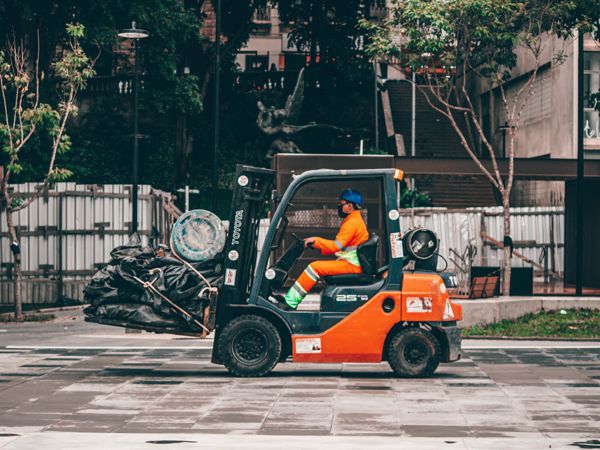
Forklifts, also known as powered industrial trucks (PITs), are essential tools found in most job sites and industrial warehouses. These machines come in various types, each with its own set of safety requirements. Understanding the differences between forklift models is crucial for safe operation.
Although forklifts are generally safer than large construction equipment like cranes or excavators, they still pose significant risks that can lead to serious injuries. According to OSHA, forklift overturns are the leading cause of forklift-related deaths, accounting for about 25% of all fatalities. In the U.S., nearly 100 workers die each year, and over 20,000 are seriously injured due to forklift accidents (refer to the NOISH report).
Diesel-powered forklifts are designed for outdoor use because they emit harmful fumes. Using them indoors without proper ventilation can be extremely dangerous. Many facilities use colored tape to mark forklift zones, helping workers stay aware of their surroundings. Mirrors placed near corners also assist operators and pedestrians in seeing each other when visibility is limited.
Handling the Forklift Load Preparation
Proper load preparation is essential to prevent forklift tipping. Always ensure the load is centered and balanced. An off-center load increases the risk of an accident.
- Secure the load so it remains stable and properly arranged.
- Inspect the load for damage. If damaged, secure it with wrapping or banding.
- Center the load on the forks.
- If the load cannot be centered, move slowly and exercise extra caution.
- Place the heaviest part of the load closest to the front wheels to help maintain balance.
- Never overload the forklift. Know its weight capacity and consider any attachments used.
- The forklift’s capacity is based on a specific load center. If the load is off-center, oversized, or unevenly distributed, it may exceed the rated capacity and cause instability.
- Use the load extension backrest for added stability.
Takeaway: The top image shows a properly balanced forklift load, while the bottom image displays an imbalanced and potentially dangerous load. Improperly balanced loads can lead to forklift tip-overs.
Approaching the Forklift Load
- Approach the load slowly and stop 8–12 inches away.
- Position the truck perpendicular to the load with the forks at the correct height.
- Set the direction control to neutral.
- Do not move the forks until the forklift has fully stopped and the brakes are engaged.
- Use the inching pedal to carefully maneuver the load into position.
Notes: Stopping 8–12 inches in front of the load gives you enough space to safely adjust the forks.
Mast Position
- Monitor the load while moving the mast. It can become unbalanced during movement.
- Be cautious when tilting the load. Only tilt forward when lifting or placing the load.
- When stacking, tilt the mast back just enough to stabilize the load.
- Travel with the mast tilted back to keep the load steady.
- Tilt the mast forward carefully when positioning the load on the stack.
- Never travel with the load tilted forward. This increases the load's distance from the center of gravity, making it less stable.
Notes: The mast should be vertical when approaching a load.
Notes: Tilting the mast forward increases the load distance and makes the load less stable.
Notes: Tilting the mast back reduces the load distance and helps maintain balance.
Positioning Forklift Forks
- Ensure the forks are level before inserting them into the pallet.
- Place the forks under the load as far as possible to help center the weight.
- Slide the forks into the pallet until they are fully underneath the load. They should be at least two-thirds the length of the load. If this isn’t possible, consider using a different forklift.
- Be careful not to puncture or hit objects on the other side of the pallet.
- Center the weight of the load between the forks. Adjust the forks to distribute the weight evenly.
- Slowly tilt the mast back to stabilize the load. This helps keep the center of gravity aligned.
Notes: Slide the forks fully under the load, but avoid extending beyond the pallet to prevent hitting other objects. At least two-thirds of the fork length should be under the pallet for safe lifting.
Lifting the Load
- Check for overhead clearance before raising the load. Look for pipes, lights, or installations.
- Lift the load slightly above the lower stack—about 4 inches—and make sure it is stable.
- Lift the load and then tilt the mast back slightly to rest it against the backrest extension.
- Ensure the load is not caught on anything or moving unintentionally.
- Slowly return the lift control lever to the neutral position.
Notes: Lift the load slowly and carefully, ensuring it is balanced and under control.
Lowering the Load
- Be cautious of falling objects and potential collisions when lowering the load.
- Return the mast to a vertical position before lowering the load.
- Lower the load so that its lowest point is 6–8 inches above the floor.
Notes: Tilting the mast backward helps stabilize the load during the lowering process.
Group Discussion Topics
- Is your forklift in good working condition? Perform a daily visual inspection of tires, hydraulic lines, and signs.
- What are the common forklift hazards in your workplace?
- Is your forklift suitable for indoor or outdoor use?
- Are bystanders and other workers aware that a forklift is operating nearby?
- What could cause a forklift to roll over?
Find Similar Articles By Topic
#material handling #forklifts #toolbox talks #construction
Customized Special Screw Barrel
Customized Special Screw Barrel,Customized Screw Barrel,Injection Molding Screw Design,Custom Screws And Barrels
Ningbo Jinyi Precision Machinery Co., Ltd. , https://www.jinyi-machinery.com
